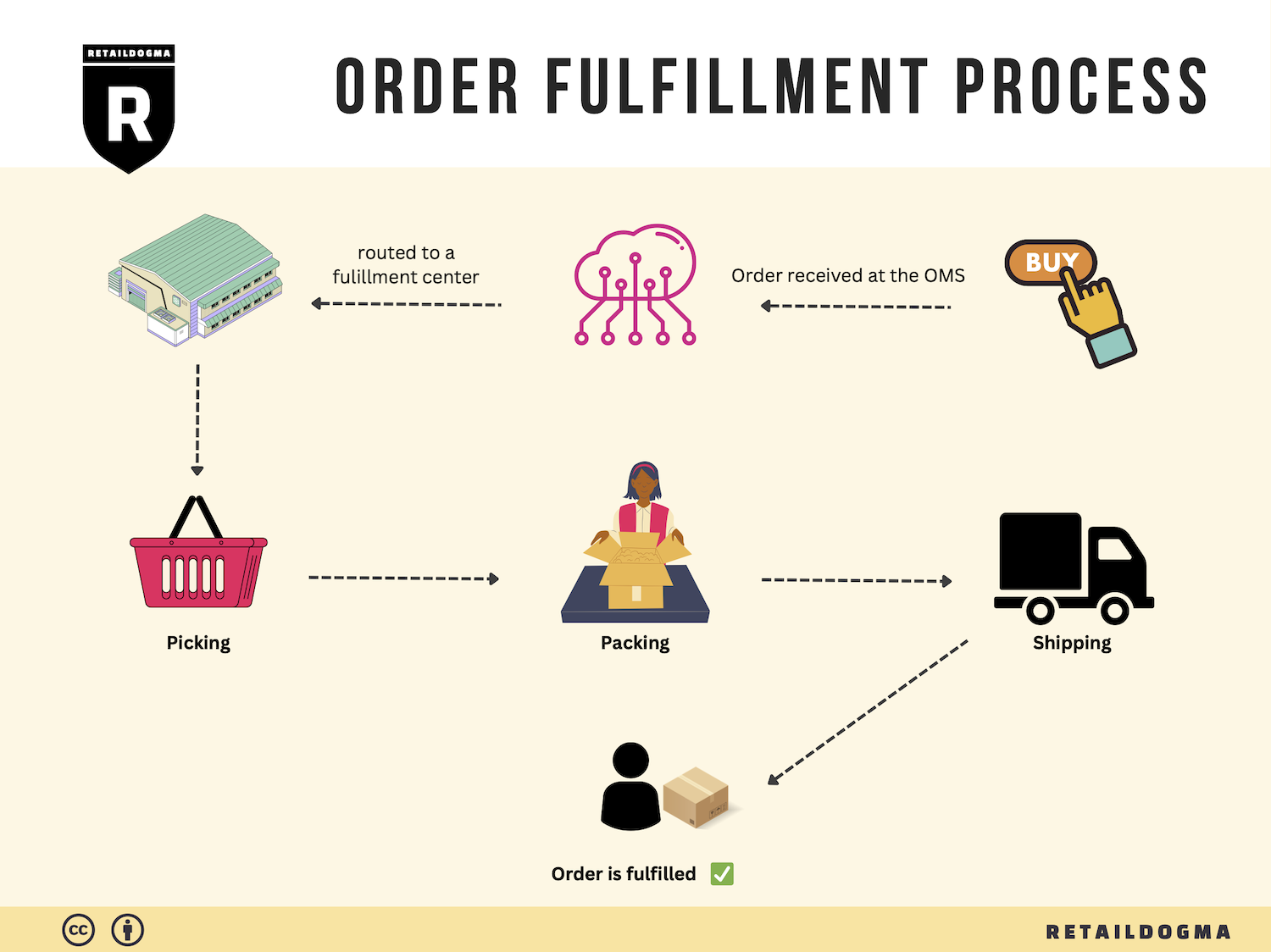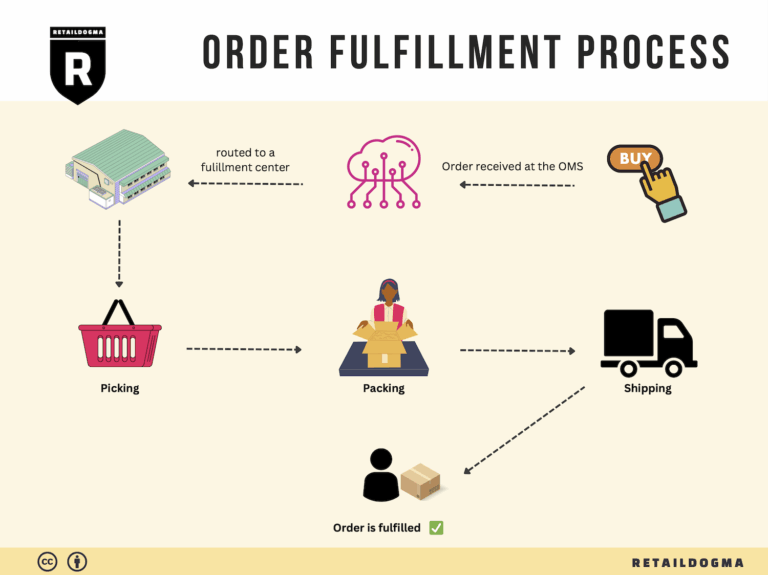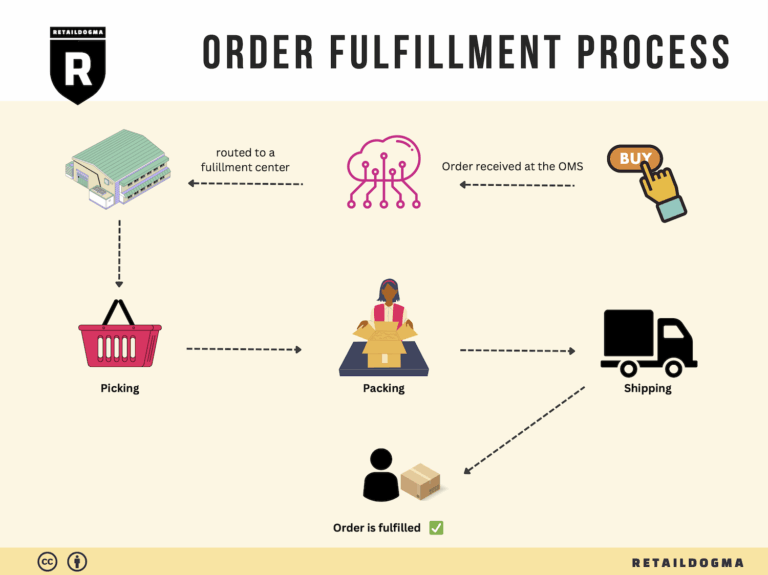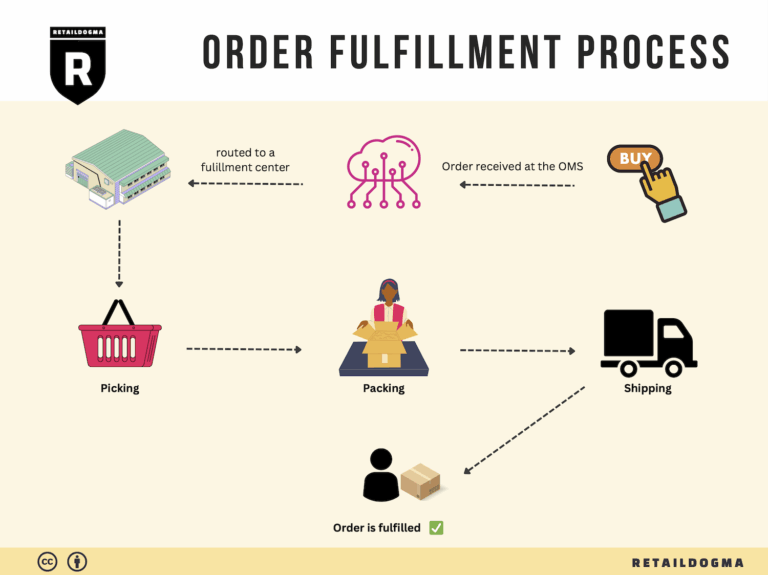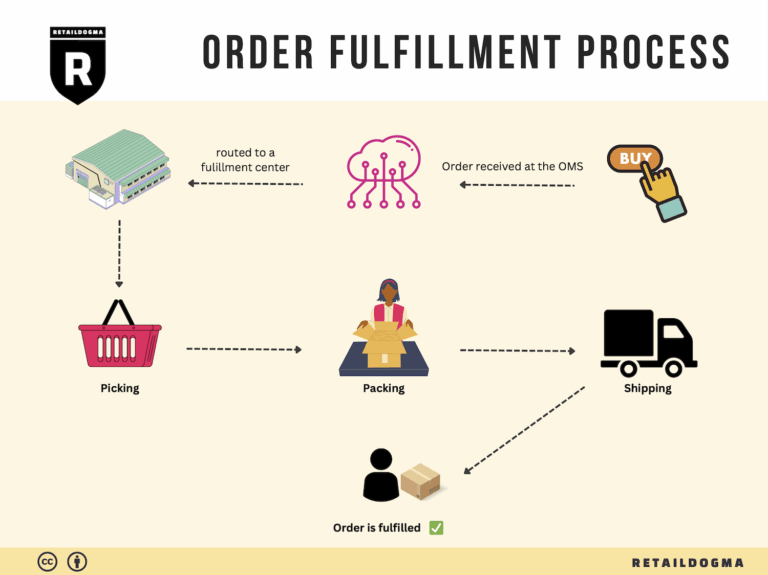What Is A Fulfillment Center? A Complete Guide (2025)
What is E-commerce Fulfillment? An Introduction for Growing Businesses
Understanding E-commerce Fulfillment: A Crucial Step for Growth
As an e-commerce business owner, you may find yourself drowning in the complexities of packing and shipping orders. The excitement of growing sales can quickly turn into stress when you realize that managing logistics is a significant undertaking. This is where e-commerce fulfillment comes into play. At its core, fulfillment is the process of receiving, processing, and delivering products to customers. It encompasses everything from inventory management to the final delivery, making it a vital component of your business operations.
In this guide, we will delve into the various models of e-commerce fulfillment that can help streamline your logistics. You will learn about third-party logistics (3PL), Fulfillment by Amazon (FBA), and other options that can take the burden off your shoulders, allowing you to focus on scaling your business. Each model has its advantages and challenges, and understanding these will empower you to make the best choice for your unique needs.
We’ll also explore the core services associated with e-commerce fulfillment. This includes order processing, inventory management, packing, shipping, and returns handling. Knowing what services are available will help you assess potential partners more effectively and ensure that you are equipped to meet customer expectations.
Choosing the right fulfillment partner is a crucial decision that can impact your brand’s reputation and customer satisfaction. In this guide, we’ll provide insights into what to look for in a fulfillment partner, including their technology capabilities, service levels, geographic reach, and customer support. We’ll also address how to evaluate pricing models to ensure you are getting the best value for your investment.
Our goal is to empower you with the knowledge you need to make informed decisions about your logistics strategy. By understanding the nuances of e-commerce fulfillment, you can streamline your operations, enhance customer satisfaction, and ultimately drive sales growth. Whether you are a startup looking to establish a solid foundation or an established business aiming to scale, this guide is designed to provide practical, actionable insights that will help you navigate the world of e-commerce fulfillment with confidence.
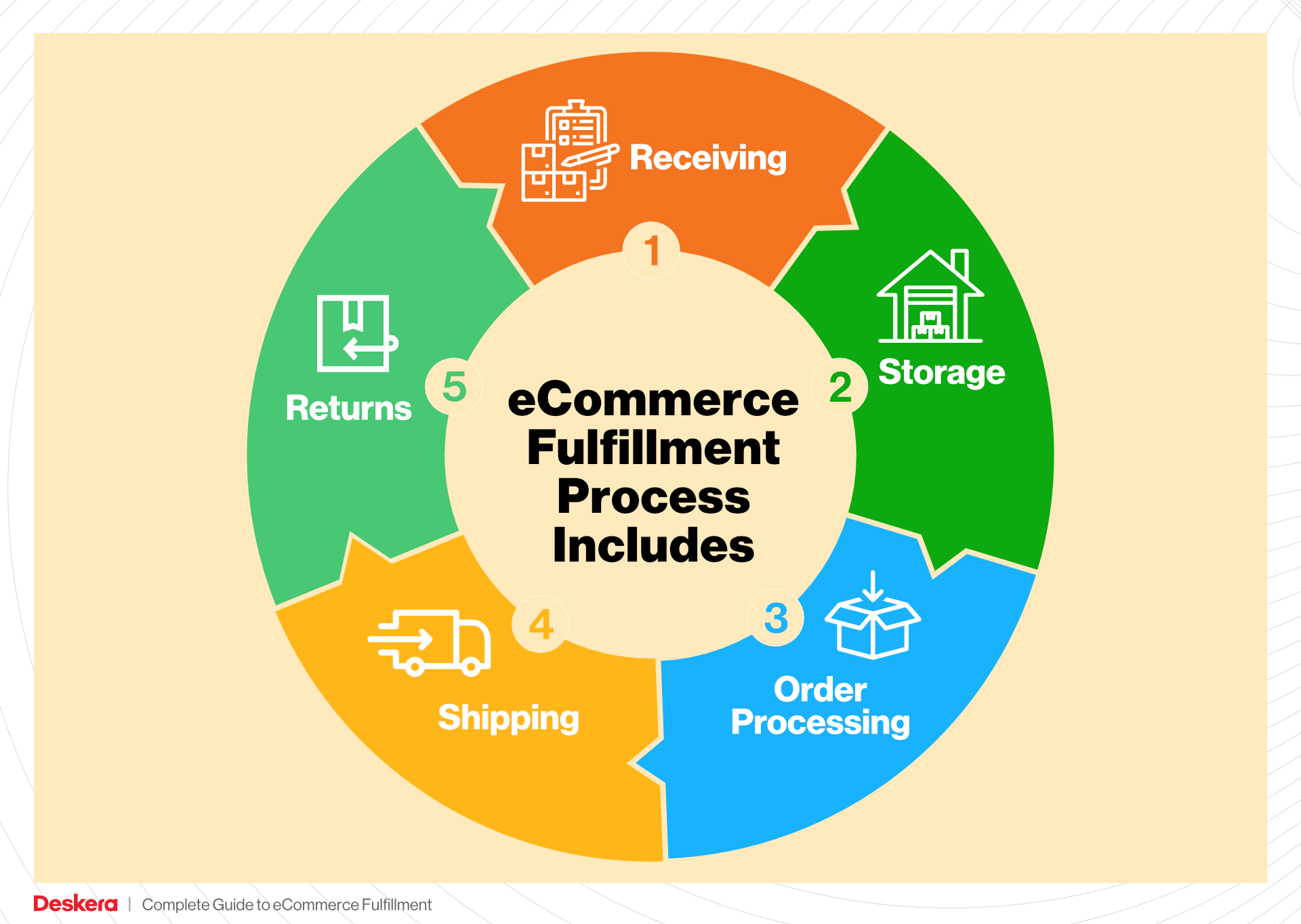
What You’ll Learn In This Guide
- What is E-commerce Fulfillment? An Introduction for Growing Businesses
- The Order Fulfillment Process: From ‘Buy’ Button to Customer’s Door
- Comparing Fulfillment Models: In-House vs. 3PL vs. Dropshipping
- A Deep Dive into Amazon FBA: Pros, Cons, and Who It’s For
- Core Services Offered by Fulfillment Centers
- How to Choose a Fulfillment Partner: A 6-Point Checklist
- Understanding Fulfillment Pricing: A Breakdown of Common Fees
- Frequently Asked Questions (FAQs) about Fulfillment
- Conclusion: Is Outsourcing Fulfillment the Right Move for Your Business?
- Important Disclaimer
The Order Fulfillment Process: From ‘Buy’ Button to Customer’s Door
1. Receiving Inventory
The first step in the order fulfillment process is receiving inventory. This involves the arrival of products from suppliers to your warehouse or fulfillment center. When the shipment arrives, staff members check the goods against the purchase order to ensure that everything is accounted for and in good condition. Key terms associated with this step include SKU (Stock Keeping Unit), which is a unique identifier for each product variant that helps in tracking inventory accurately.
This step is crucial because it lays the foundation for efficient inventory management. Accurate receiving helps prevent stock discrepancies, which can lead to stockouts or overstock situations. Proper checks during this phase can also identify damaged goods before they are stored, ensuring that only sellable products are available for order fulfillment.
2. Warehouse Storage
Once the inventory is received, the next step is warehouse storage. This involves organizing the products in a systematic manner within the warehouse. Efficient storage strategies often employ bin locations, which are designated spots where specific items are kept. This can involve shelving units, pallet racks, or other storage solutions based on the size and nature of the products.
The importance of effective warehouse storage cannot be overstated. It directly impacts the speed and efficiency of the picking process. A well-organized warehouse minimizes the time staff spend searching for items, reduces the likelihood of errors, and improves overall operational efficiency. Additionally, leveraging technology such as Warehouse Management Systems (WMS) can enhance inventory visibility and tracking.
3. Order Picking
The third step is order picking, where staff members retrieve items from their designated storage locations to fulfill customer orders. This process often utilizes pick lists, which detail the items and quantities needed for each order. Orders can be picked in various ways, including single order picking, batch picking, or wave picking, depending on the size and nature of the orders.
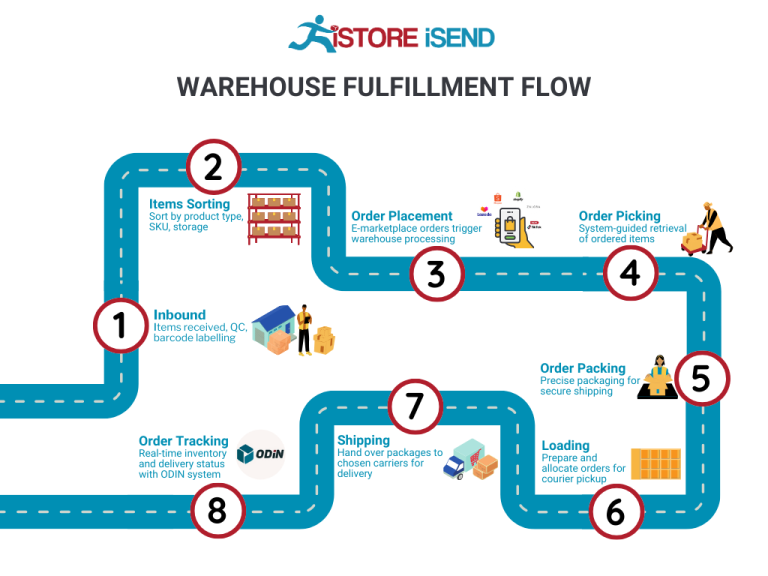
Order picking is a critical phase in the fulfillment process, as it directly influences order accuracy and customer satisfaction. Errors during this step can lead to incorrect shipments, resulting in returns and customer dissatisfaction. Therefore, implementing best practices such as double-checking items and using technology like barcode scanners can significantly enhance picking accuracy and efficiency.
4. Order Packing
After items have been picked, the next step is order packing. This involves securely packaging the products for shipment, ensuring they are protected during transit. Key considerations during this phase include the use of appropriate packing materials, such as void fill (to prevent movement within the box) and shipping labels, which provide essential information for delivery.
The packing process is vital because it directly affects the delivery experience. Properly packed orders reduce the risk of damage during shipping, which can lead to costly returns and customer dissatisfaction. Additionally, efficient packing can help optimize shipping costs by minimizing the size and weight of packages, which is crucial for maintaining competitive pricing.
5. Shipping & Delivery
The final step in the order fulfillment process is shipping and delivery. This involves selecting the appropriate shipping carriers and methods to deliver the packages to customers. Key terms associated with this step include tracking numbers, which allow both the business and the customer to monitor the shipment’s progress.
This step is critical for customer satisfaction, as timely delivery can significantly impact the overall shopping experience. Businesses must choose reliable carriers and consider factors such as shipping speed, cost, and geographic coverage. Implementing automated shipping solutions can streamline this process, allowing businesses to provide accurate delivery estimates and improve communication with customers regarding their order status.
In conclusion, understanding and optimizing each step of the order fulfillment process is essential for e-commerce businesses aiming to scale operations effectively. By focusing on receiving inventory, warehouse storage, order picking, order packing, and shipping & delivery, businesses can enhance efficiency, reduce errors, and ultimately improve customer satisfaction.
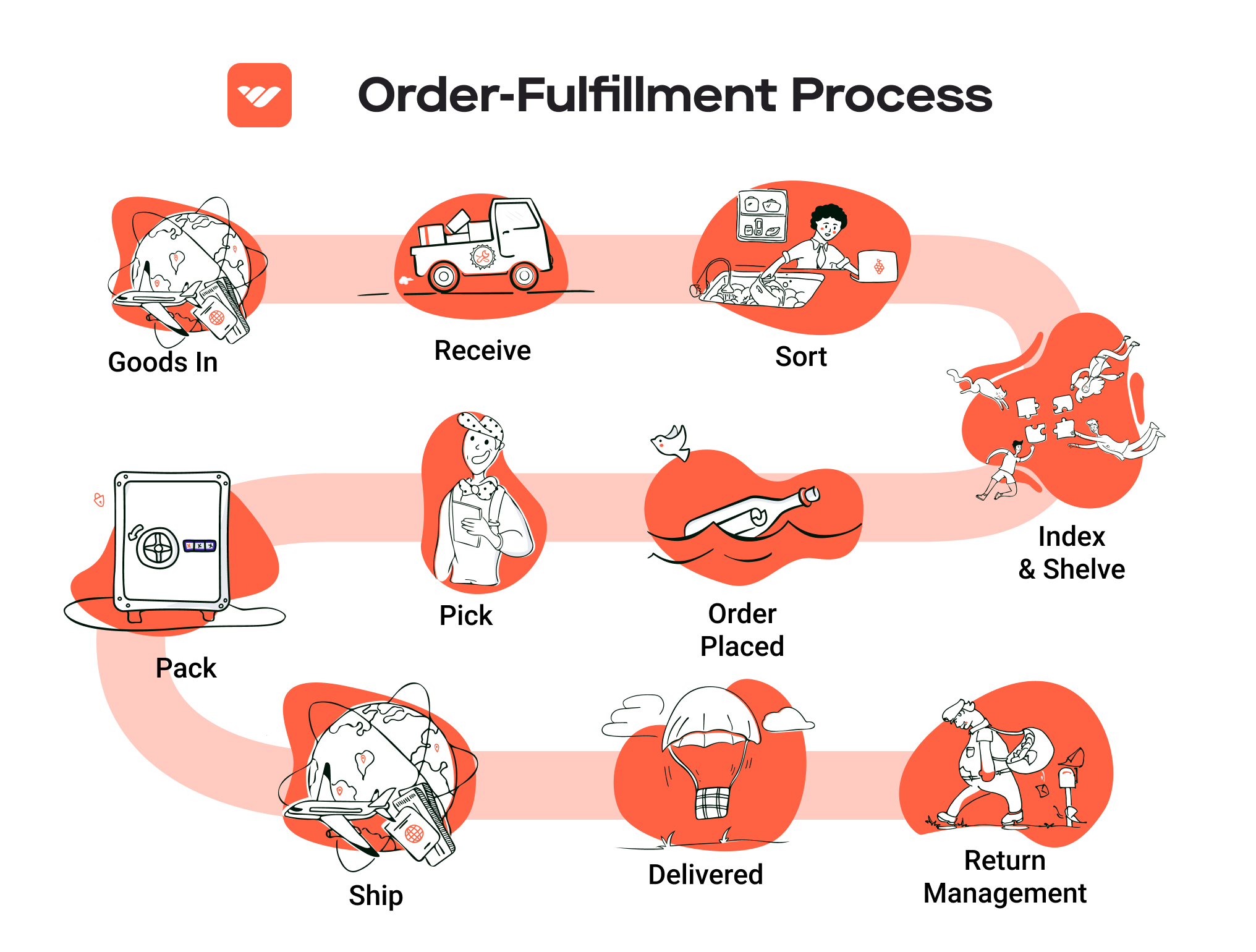
Comparing Fulfillment Models: In-House vs. 3PL vs. Dropshipping
Fulfillment Model Comparison
| Model | Who Handles Inventory | Best For (Business Stage) | Key Advantage | Key Disadvantage |
|---|---|---|---|---|
| In-House Fulfillment | Your own team | Established businesses | Full control over inventory and operations | High overhead costs and resource-intensive |
| Third-Party Logistics (3PL) | 3PL provider | Growing businesses | Scalable solutions and expertise | Less control over logistics and possible delays |
| Dropshipping | Supplier or manufacturer | Startups and small businesses | Low startup costs and no inventory risk | Lower profit margins and reliance on suppliers |
In-House Fulfillment
In-house fulfillment involves managing the entire process of inventory storage, order processing, and shipping within your own facilities. This model is typically adopted by established businesses that have the resources and operational capacity to handle logistics internally. The primary advantage of in-house fulfillment is the complete control it affords over every aspect of the fulfillment process. This control can lead to enhanced customer experience through faster shipping times, personalized packaging, and the ability to manage inventory levels precisely. However, this model also comes with significant disadvantages, including high overhead costs due to warehousing, staffing, and technology investments. Additionally, it can be resource-intensive, requiring businesses to dedicate considerable time and effort to manage logistics rather than focusing on core competencies like marketing and product development. As businesses grow, the complexity of managing in-house fulfillment can become a limiting factor, prompting a reevaluation of the fulfillment strategy.
Third-Party Logistics (3PL)
Third-party logistics (3PL) providers offer a comprehensive suite of services that include warehousing, inventory management, order fulfillment, and shipping. This model is well-suited for growing businesses that require scalable solutions without the burden of managing logistics themselves. By partnering with a 3PL, businesses can leverage the expertise and infrastructure of established logistics providers, which can lead to cost savings and increased efficiency. Additionally, 3PLs often have the technology and resources to handle complex logistics needs, such as international shipping and returns management. However, one of the main disadvantages of using a 3PL is the potential loss of control over logistics operations. Businesses may face challenges with communication and coordination, which can lead to delays and customer dissatisfaction if not managed properly. Moreover, reliance on a third party can create risks, especially if the provider faces operational issues or fails to meet service level agreements.
Dropshipping
Dropshipping is a fulfillment model where the retailer does not keep products in stock. Instead, when a store sells a product, it purchases the item from a third-party supplier who then ships it directly to the customer. This model is particularly advantageous for startups and small businesses because it requires minimal upfront investment and eliminates the need for inventory management. Entrepreneurs can focus on marketing and customer service without the financial burden of holding inventory. However, dropshipping also presents significant challenges. The primary disadvantage is the lower profit margins, as retailers typically pay wholesale prices to suppliers. Additionally, businesses are reliant on suppliers for product availability and shipping speed, which can lead to fulfillment issues if suppliers face delays or stock shortages. This lack of control can affect customer satisfaction and brand reputation. Ultimately, while dropshipping offers a low-risk entry into e-commerce, it requires careful supplier selection and management to ensure a positive customer experience.
In conclusion, each fulfillment model presents unique advantages and challenges that can significantly impact an e-commerce business’s growth and operations. Selecting the right model depends on various factors, including the business’s stage, resource availability, and long-term goals. As businesses scale, they may find it beneficial to reassess their fulfillment strategy to align with changing needs and market demands.
A Deep Dive into Amazon FBA: Pros, Cons, and Who It’s For
Understanding Fulfillment by Amazon (FBA)
Fulfillment by Amazon (FBA) is a service provided by Amazon that allows sellers to store their products in Amazon’s fulfillment centers. Amazon then takes care of storage, packaging, and shipping of these products directly to customers. This service enables sellers to leverage Amazon’s vast logistics network and customer base, streamlining their order fulfillment process.
When a customer purchases a product listed with FBA, Amazon handles the entire transaction, including customer service and returns. This allows sellers to focus on other aspects of their business, such as product development and marketing, while Amazon manages the logistics.
How FBA Works
-
Sign Up and Setup: Sellers start by creating an Amazon seller account. They then enroll in FBA, allowing Amazon to fulfill their orders.
-
Product Listing: Sellers list their products on Amazon. They can choose to use FBA for all or some of their listings.
-
Shipping Inventory: Sellers send their products to Amazon’s fulfillment centers. Amazon provides guidelines on how to package and label products to ensure they are received properly.
-
Storage and Inventory Management: Once the products arrive at the fulfillment center, Amazon stores them. Sellers can monitor their inventory levels through their seller dashboard.
-
Order Processing: When a customer places an order, Amazon picks, packs, and ships the product on behalf of the seller.
-
Customer Service and Returns: Amazon handles customer inquiries and processes returns, allowing sellers to provide a seamless shopping experience.
Pros of Using FBA
-
Prime Eligibility: Products fulfilled by Amazon are eligible for Amazon Prime, which attracts more customers who value fast shipping options. This can significantly increase sales as Prime members often prefer products that offer free two-day shipping.
-
Enhanced Customer Trust: Leveraging Amazon’s brand credibility can enhance customer trust. Buyers are more likely to purchase from sellers using FBA due to Amazon’s reputation for reliability and customer service.
-
Multi-Channel Fulfillment: FBA isn’t limited to Amazon. Sellers can use FBA to fulfill orders from other sales channels, such as their own websites or other e-commerce platforms. This flexibility allows for greater operational efficiency and inventory management.
-
Scalability: FBA allows businesses to scale without the need for significant investment in warehousing or logistics infrastructure. Sellers can grow their product offerings and reach new markets without worrying about the complexities of fulfillment.
-
Time Savings: By outsourcing fulfillment, sellers can free up valuable time and resources that can be redirected toward marketing, product development, and customer engagement.
Cons of Using FBA
-
High Fees: FBA incurs various fees, including storage fees and fulfillment fees. These can add up quickly, especially for sellers with low margins or slow-moving inventory. It’s essential to analyze these costs to ensure profitability.
-
Strict Inventory Rules: Amazon has stringent guidelines regarding inventory management, including restrictions on certain products and requirements for labeling. Non-compliance can lead to additional charges or penalties, and in some cases, inventory removal.
-
Commingling Risks: FBA products are often commingled, meaning that products from multiple sellers may be stored together. This can lead to issues where a customer receives a different product than expected, potentially harming seller ratings and leading to returns.
-
Limited Control Over Fulfillment: Sellers relinquish control over the fulfillment process. This means they cannot directly manage shipping times, packaging, or customer service interactions, which can be a concern for brands that prioritize customer experience.
-
Inventory Limitations: Amazon sets limits on the amount of inventory sellers can store, which can hinder growth for high-demand products. Sellers must carefully manage their inventory levels to avoid running out of stock or incurring excess storage fees.
Who is FBA Best For?
FBA is particularly well-suited for:
-
Small to Medium-Sized Businesses: Companies looking to grow their online presence without investing heavily in logistics and warehousing can benefit significantly from FBA’s scalable model.
-
Brands with High Sales Volume: Businesses that sell high volumes of products can leverage the benefits of FBA, as the fees may be offset by increased sales from Amazon Prime members.
-
Sellers in Niche Markets: Sellers offering specialized products can tap into Amazon’s vast customer base while focusing on their core competencies.
-
E-commerce Entrepreneurs: Startups and entrepreneurs looking to test the market with minimal risk and upfront investment will find FBA an attractive option for launching their products.
In conclusion, while FBA offers numerous benefits, including access to a vast customer base and efficient logistics management, it is essential for sellers to weigh these advantages against the potential drawbacks, such as high fees and limited control over fulfillment. By carefully considering their business model and goals, sellers can make an informed decision on whether FBA is the right fit for them.
Core Services Offered by Fulfillment Centers
Inventory Management & Warehousing
Fulfillment centers provide robust inventory management and warehousing services that are critical for e-commerce businesses. This service involves the systematic tracking, storing, and managing of products in a centralized location. By leveraging advanced inventory management systems, fulfillment centers can offer real-time visibility of stock levels, automate reordering processes, and prevent overstocking or stockouts.
The benefits of effective inventory management for an e-commerce business are manifold. First, it allows for efficient space utilization and organization of products, which can significantly reduce storage costs. Second, with accurate inventory tracking, businesses can make informed decisions about purchasing and sales strategies, ensuring that they meet customer demand without tying up capital in excess inventory. Moreover, having a well-organized warehouse can expedite order processing times, leading to faster delivery and improved customer satisfaction. By outsourcing these functions to a fulfillment center, e-commerce businesses can focus on core activities such as marketing and customer engagement, ultimately driving growth.
Pick and Pack Services
Pick and pack services are a fundamental offering of fulfillment centers, encompassing the picking of items from inventory and packaging them for shipment to customers. This process involves selecting the correct products based on customer orders, carefully packing them to prevent damage during transit, and labeling packages for delivery.
The value of pick and pack services lies in their efficiency and accuracy. Fulfillment centers employ trained staff and sophisticated technology to ensure that the correct items are picked and packed promptly. This reduces the likelihood of errors that can lead to returns and customer dissatisfaction. Additionally, fast and reliable order fulfillment can enhance a business’s reputation, as customers increasingly expect quick delivery times. By utilizing these services, e-commerce businesses can scale operations without the need to invest in additional manpower or resources, allowing them to respond swiftly to market demands.
Kitting and Assembly
Kitting and assembly services offered by fulfillment centers involve the grouping of individual items into ready-to-ship kits or products. This service is particularly valuable for businesses that sell products that require assembly or for those offering promotional bundles. Kitting can include tasks such as assembling components, packaging items together, or creating customized sets based on customer specifications.
The primary advantage of kitting and assembly services is that they streamline the order fulfillment process. By pre-assembling products, fulfillment centers reduce the time required to complete orders, which can lead to faster shipping times. This is especially beneficial during peak sales periods, such as holidays or promotional events, when demand surges. Furthermore, offering bundled products can increase average order value and enhance customer satisfaction, as customers appreciate the convenience of receiving everything they need in one package. By outsourcing kitting and assembly to fulfillment centers, e-commerce businesses can enhance their product offerings while minimizing operational complexity.
Returns Management (Reverse Logistics)
Returns management, also known as reverse logistics, is a critical service provided by fulfillment centers that deals with the return process of products from customers back to the warehouse. This service includes processing returns, inspecting items for damage, restocking inventory, and managing customer communications regarding returns.
The significance of effective returns management cannot be overstated, as it directly impacts customer satisfaction and brand loyalty. A streamlined returns process makes it easier for customers to return items, which can help reduce friction and encourage repeat purchases. Additionally, fulfillment centers can implement data analysis to identify trends in returns, allowing e-commerce businesses to address underlying issues, such as product quality or sizing discrepancies.
Moreover, efficient returns management can recover value from returned items by reintegrating them into inventory or refurbishing them for resale. This not only helps minimize losses but also supports sustainability efforts by reducing waste. By partnering with fulfillment centers that specialize in returns management, e-commerce businesses can enhance their overall customer experience and improve operational efficiency.
Conclusion
In summary, the core services offered by fulfillment centers—inventory management and warehousing, pick and pack services, kitting and assembly, and returns management—play a vital role in the success of e-commerce businesses. By leveraging these services, companies can enhance operational efficiency, improve customer satisfaction, and scale their operations effectively. As the e-commerce landscape continues to evolve, partnering with a proficient fulfillment center can provide the competitive edge necessary for sustained growth and success.
How to Choose a Fulfillment Partner: A 6-Point Checklist
Location & Warehouse Network
Importance: The geographical location of your fulfillment partner’s warehouses significantly impacts shipping times and costs. A well-positioned network can enhance customer satisfaction through faster deliveries and lower shipping fees.
Questions to Ask:
– Where are your warehouses located, and how does that align with my customer base?
– Do you have multiple locations to allow for regional distribution?
– How do you handle shipping to remote areas?
– What shipping carriers do you partner with, and what are their delivery times?
Technology & Integrations
Importance: The technology stack of your fulfillment partner is crucial for seamless operations. An advanced system can automate various processes, from inventory management to order tracking, thus improving efficiency and accuracy.
Questions to Ask:
– What fulfillment management system (FMS) do you use, and how does it integrate with my e-commerce platform?
– Can you provide real-time inventory updates, and how are these communicated?
– Do you support API integrations for custom solutions?
– How do you handle order tracking and notifications for customers?
Specializations (e.g., Cold Storage, Oversized Items)
Importance: Depending on your product range, you may require specialized services. Whether it’s cold storage for perishables or handling oversized items, ensuring your partner can meet these needs is vital for maintaining product integrity and customer satisfaction.
Questions to Ask:
– Do you have specialized facilities for my product type, such as cold storage or hazardous materials?
– What are your capabilities in handling oversized or fragile items?
– Can you manage returns or damaged goods effectively?
– How do you ensure compliance with industry regulations for specialized products?
Scalability & Capacity
Importance: As your business grows, your fulfillment needs will evolve. Partnering with a fulfillment provider that can scale with your operations ensures you won’t face bottlenecks as your order volume increases.
Questions to Ask:
– What is your current capacity, and how do you handle peak seasons or sudden spikes in demand?
– Can you provide examples of how you’ve supported other businesses in scaling?
– What are your policies regarding additional storage and labor during busy periods?
– How do you manage inventory turnover and stock levels to prevent overstocking or stockouts?
Pricing and Contracts
Importance: Understanding the pricing structure and contractual obligations is essential to avoid unexpected costs and ensure that the partnership remains profitable as your business grows.
Questions to Ask:
– What are your pricing models (e.g., per order, per item, monthly fees) and what do they include?
– Are there any hidden fees for services such as returns, storage, or additional handling?
– What is the length of the contract, and what are the terms for cancellation or renegotiation?
– Do you offer volume discounts or incentives for long-term partnerships?
Customer Support & Reviews
Importance: Reliable customer support is critical for addressing issues quickly and maintaining operational flow. Additionally, checking reviews and testimonials can provide insight into the partner’s reliability and service quality.
Questions to Ask:
– What customer support channels do you offer (e.g., phone, email, chat), and what are their hours of operation?
– How quickly can I expect a response to inquiries or issues?
– Can you provide references or case studies from existing clients?
– What is your process for handling errors or discrepancies in orders?
Conclusion
Choosing the right fulfillment partner is a strategic decision that can significantly impact your e-commerce business’s success. By thoroughly evaluating potential partners against this checklist, you can make a more informed choice that aligns with your operational needs and growth objectives. Remember, the right partner should not only meet your current requirements but also be able to adapt and grow with your business over time.
Understanding Fulfillment Pricing: A Breakdown of Common Fees
Initial Setup Fees
Initial setup fees are a one-time charge that e-commerce businesses often encounter when engaging a fulfillment center. These fees cover the costs associated with onboarding your business into the fulfillment system. This may include creating and configuring your account, integrating your e-commerce platform with the fulfillment provider’s system, and establishing inventory management protocols.
The calculation of initial setup fees varies widely among providers, but they can range from a few hundred to several thousand dollars, depending on the complexity of the setup. Factors influencing the cost include the number of SKUs you have, the degree of customization required for your integrations, and any special handling instructions for your products.
Receiving Fees
Receiving fees are incurred when your products arrive at the fulfillment center. These charges cover the labor and equipment needed to unload, inspect, and store your inventory. Receiving fees are typically calculated based on the volume of goods received, often measured in pallets, boxes, or individual items.
Providers may charge a flat fee per shipment, a variable fee based on the weight or number of items, or a combination of both. For instance, a fulfillment center might charge $25 per pallet received or $0.50 per item. Understanding this fee structure is crucial, as high receiving costs can impact your overall logistics budget, especially if you frequently replenish inventory.
Storage Fees (per pallet/bin)
Storage fees are ongoing charges that businesses must pay for keeping their inventory in the fulfillment center. These fees are generally calculated on a monthly basis and can be charged per pallet, bin, or cubic foot, depending on the provider’s pricing structure.
For example, a typical storage fee might be around $15 to $50 per pallet per month. However, rates can fluctuate based on factors such as the location of the fulfillment center, the type of products stored (e.g., bulky items may incur higher fees), and the time of year (peak seasons may lead to increased storage costs). It’s essential to factor these fees into your overall inventory management strategy, as prolonged storage can erode profit margins.
Pick & Pack Fees (per item/order)
Pick and pack fees refer to the costs associated with selecting items from inventory and preparing them for shipment. This includes picking the items, packing them securely, and labeling them for delivery. These fees are typically charged on a per-item or per-order basis, depending on the fulfillment center’s pricing model.
For example, a fulfillment center may charge $1.00 per item picked and packed, or $2.50 per order regardless of the number of items. Some providers may also offer tiered pricing, where the cost per item decreases with higher order volumes. Understanding pick and pack fees is crucial for e-commerce businesses, as they directly impact the cost of fulfilling orders and can influence pricing strategies.
Shipping Fees
Shipping fees encompass the costs associated with transporting your products from the fulfillment center to the end customer. These fees can vary widely based on multiple factors, including the shipping method (e.g., standard, expedited), package weight and dimensions, destination, and any additional services like insurance or signature confirmation.
Shipping fees are often calculated based on carrier rates (e.g., USPS, FedEx, UPS) and may include surcharges for residential deliveries or rural destinations. Businesses should be aware that some fulfillment centers offer discounted shipping rates due to partnerships with carriers, which can help lower overall costs. It’s essential to negotiate shipping rates with your fulfillment provider and ensure they align with your business’s shipping strategy.
Conclusion: Tips for Getting an Accurate Quote
To obtain an accurate fulfillment pricing quote, consider the following tips:
-
Provide Detailed Information: Share specifics about your product types, expected order volume, and any unique requirements to receive a tailored quote.
-
Ask About All Fees: Inquire about all potential fees, including hidden costs that may not be immediately apparent, such as seasonal surcharges or additional handling fees.
-
Compare Multiple Providers: Gather quotes from several fulfillment centers to understand the market rate and find the best fit for your business needs.
-
Negotiate Terms: Don’t hesitate to negotiate pricing, especially if you anticipate high order volumes or are willing to sign a long-term contract.
-
Review Terms Regularly: Fulfillment needs can change as your business scales, so regularly review and adjust your agreements to ensure they remain competitive and aligned with your growth.
By understanding these common fulfillment pricing models and using these tips, you can make informed decisions that enhance your e-commerce operations and contribute to your business’s scalability.
Frequently Asked Questions (FAQs) about Fulfillment
1. What is the difference between “fulfillment” and “fulfilment”?
The difference between “fulfillment” and “fulfilment” lies primarily in regional spelling conventions. “Fulfillment” is the standard spelling in American English, while “fulfilment” is used in British English and other Commonwealth countries. Both terms refer to the same concept of completing or delivering something promised, but the spelling you use should align with your target audience’s language preferences for clarity and credibility.
2. Why is the correct spelling of fulfillment important for my e-commerce business?
Using the correct spelling of fulfillment is crucial for maintaining professional credibility and building trust with your audience. Additionally, search engines treat “fulfillment” and “fulfilment” as separate keywords, meaning that the right spelling can significantly impact your SEO performance and visibility in specific markets.
3. How can I optimize my website for both spellings of fulfillment?
To effectively optimize for both spellings, consider creating localized versions of your website. Use “fulfillment” for U.S.-targeted sites and “fulfilment” for UK or Commonwealth audiences. Incorporate both terms in FAQs or blogs to capture a wider range of search traffic, and ensure consistent usage throughout your content to avoid confusion.
4. What is a fulfillment center?
A fulfillment center is a specialized warehouse that manages the storage, picking, packing, and shipping of products for e-commerce businesses. These centers streamline the order fulfillment process, enabling businesses to efficiently deliver products to customers without managing inventory directly.
5. What is a 3PL (Third-Party Logistics)?
A Third-Party Logistics (3PL) provider is an external company that offers logistics services, including transportation, warehousing, and fulfillment. By partnering with a 3PL, e-commerce businesses can focus on core operations while leveraging the expertise and resources of logistics specialists to manage their supply chain.
6. How much do fulfillment services cost?
The cost of fulfillment services varies widely based on several factors, including order volume, storage needs, packaging requirements, and shipping destinations. On average, fulfillment costs can range from $2 to $5 per order, with additional fees for storage, handling, and shipping. It’s essential to evaluate different providers and compare their pricing structures to find a solution that fits your budget and operational needs.
7. What factors should I consider when choosing a fulfillment partner?
When selecting a fulfillment partner, consider factors such as location, scalability, technology integration, shipping options, customer service, and pricing. Additionally, evaluate their experience in your industry and their ability to handle your specific product types and order volumes.
8. How can I improve my order fulfillment process?
To enhance your order fulfillment process, you can implement inventory management software, streamline your order processing workflow, establish clear communication with your fulfillment partner, and analyze performance metrics regularly. Investing in automation tools and optimizing your logistics network can also lead to significant improvements in efficiency and customer satisfaction.
9. What role does technology play in fulfillment?
Technology plays a critical role in modern fulfillment operations, enabling businesses to automate processes, track inventory in real-time, manage orders more efficiently, and improve customer communication. Utilizing fulfillment software can enhance accuracy, reduce errors, and provide insights into performance metrics, leading to better decision-making and operational efficiency.
10. How can I ensure customer satisfaction in my fulfillment operations?
To ensure customer satisfaction, focus on timely and accurate order processing, transparent communication regarding order status, and responsive customer service. Offering multiple shipping options, easy return processes, and personalized experiences can also enhance customer trust and loyalty, ultimately contributing to the success of your e-commerce business.
Conclusion: Is Outsourcing Fulfillment the Right Move for Your Business?
Key Benefits of Outsourcing Fulfillment
Outsourcing fulfillment can be a game-changer for e-commerce businesses seeking to scale efficiently. By leveraging a fulfillment service, companies can save significant time and resources, allowing them to focus on core business activities such as marketing and product development. Fulfillment partners streamline order processing, inventory management, and shipping logistics, enabling businesses to respond more swiftly to market demands without the burden of managing these complex operations in-house.
Moreover, the scalability offered by fulfillment services is a crucial advantage. As your business grows, so do the complexities of order fulfillment. A reliable partner can easily adapt to fluctuations in order volume, providing the flexibility needed to accommodate seasonal spikes or unexpected growth. This adaptability ensures that your customers receive their orders promptly, enhancing satisfaction and loyalty.
Additionally, fulfillment providers bring specialized expertise to the table. They have extensive knowledge of logistics, shipping regulations, and best practices, which can significantly reduce errors and improve delivery times. This expertise not only optimizes your operations but also helps in maintaining compliance with international shipping standards, which is vital for businesses looking to expand their reach globally.
Choosing the Right Partner
However, the benefits of outsourcing fulfillment hinge on selecting the right partner. It’s essential to conduct thorough research and due diligence to ensure that your fulfillment provider aligns with your business goals and customer expectations. Look for partners with proven track records, transparent pricing structures, and robust technology platforms that integrate seamlessly with your e-commerce systems.
Take Action
To determine if outsourcing fulfillment is the right next step for your business, conduct an audit of your current shipping process. Assess your operational challenges, customer feedback, and growth projections. This analysis will help you understand whether a fulfillment partner can enhance your efficiency, scalability, and customer satisfaction, ultimately paving the way for your business’s growth. Start exploring your options today and position your e-commerce brand for success in a competitive marketplace.
Important Disclaimer
⚠️ Important Disclaimer
The information in this guide is for educational purposes. Fulfillment services, pricing, and platform features change frequently. Always conduct your own due diligence and consult with providers directly before making business decisions.
